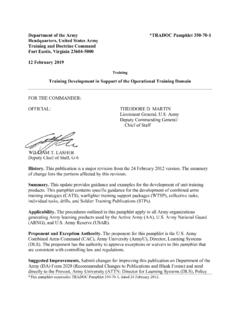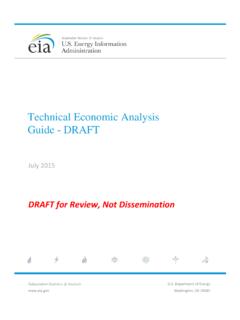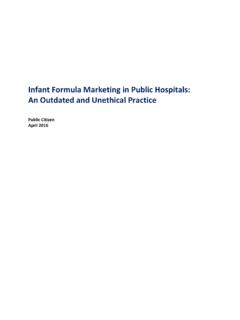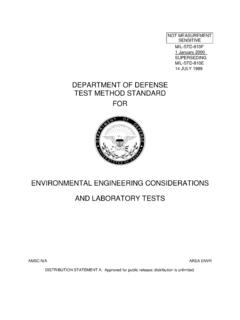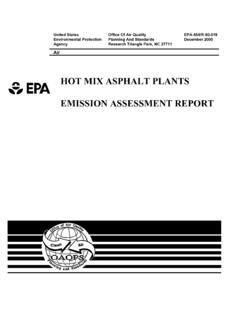Transcription of APPENDIX G ENVIRONMENTAL CHECKLIST FORM
1 APPENDIX G ENVIRONMENTAL CHECKLIST FORM NOTE: The following is a sample form that may be tailored to satisfy individual agencies needs and project circumstances. It may be used to meet the requirements for an initial study when the criteria set forth in CEQA Guidelines have been met. Substantial evidence of potential impacts that are not listed on this form must also be considered. The sample questions in this form are intended to encourage thoughtful assessment of impacts, and do not necessarily represent thresholds of significance. title: agency name and person and phone number: location: sponsor's name and address:_____ _____ plan of project: (Describe the whole action involved, including but not limited to laterphases of the project, and any secondary, support, or off-site features necessary for itsimplementation.)
2 Attach additional sheets if necessary.)_____ _____ _____ _____ _____ _____ _____ land uses and setting: (Briefly describe the project's surroundings)_____ _____ _____ Page public agencies whose approval is required: ( , permits, financing approval, orparticipation agreement.) California Native American tribes traditionally and culturally affiliated with the projectarea requested consultation pursuant to Public Resources Code section If so, isthere a plan for consultation that includes, for example, the determination of significance ofimpacts to tribal cultural resources, procedures regarding confidentiality, : Conducting consultation early in the CEQA process allows tribal governments, lead agencies, and project proponents to discuss the level of ENVIRONMENTAL review, identify and address potential adverse impacts to tribal cultural resources, and reduce the potential for delay and conflict in the ENVIRONMENTAL review process.
3 (See Public Resources Code section ) Information may also be available from the California Native American Heritage Commission s Sacred Lands File per Public Resources Code section and the California Historical Resources Information System administered by the California Office of Historic Preservation. Please also note that Public Resources Code section (c) contains provisions specific to confidentiality. Page 2 ENVIRONMENTAL FACTORS POTENTIALLY AFFECTED: The ENVIRONMENTAL factors checked below would be potentially affected by this project, involving at least one impact that is a Potentially Significant Impact, as indicated by the CHECKLIST on the following pages.
4 Aesthetics Biological Resources Geology/Soils Hydrology/Water Quality Noise Recreation Utilities / Service Systems Agriculture / Forestry Resources Cultural Resources Greenhouse Gas Emissions Land Use / Planning Population / Housing Transportation Wildfire Air Quality Energy Hazards and Hazardous Materials Mineral Resources Public Services Tribal Cultural ResourcesMandatory Findings of Significance DETERMINATION On the basis of this initial evaluation: I find that the proposed project COULD NOT have a significant effect on the environment, and a NEGATIVE DECLARATION will be prepared. I find that although the proposed project could have a significant effect on the environment, there will not be a significant effect in this case because revisions in the project have been made by or agreed to by the project proponent.
5 A MITIGATED NEGATIVE DECLARATION will be prepared. I find that the proposed project MAY have a significant effect on the environment, and an ENVIRONMENTAL IMPACT REPORT is required. I find that the proposed project MAY have a potentially significant impact or potentially significant unless mitigated impact on the environment, but at least one effect 1) has been adequately analyzed in an earlier document pursuant to applicable legal standards, and 2) has been addressed by mitigation measures based on the earlier analysis as described on attached sheets. An ENVIRONMENTAL IMPACT REPORT is required, but it must analyze only the effects that remain to be addressed.
6 I find that although the proposed project could have a significant effect on the environment, because all potentially significant effects (a) have been analyzed adequately in an earlier EIR or NEGATIVE DECLARATION pursuant to applicable standards, and (b) have been avoided or mitigated pursuant to that earlier EIR or NEGATIVE DECLARATION, including revisions or mitigation measures that are imposed upon the proposed project, nothing further is required. Signature Date Page 3 EVALUATION OF ENVIRONMENTAL IMPACTS brief explanation is required for all answers except No Impact answers that areadequately supported by the information sources a lead agency cites in the parenthesesfollowing each question.
7 A No Impact answer is adequately supported if the referencedinformation sources show that the impact simply does not apply to projects like the oneinvolved ( , the project falls outside a fault rupture zone). A No Impact answer should beexplained where it is based on project-specific factors, as well as general standards ( ,the project would not expose sensitive receptors to pollutants, based on a project-specificscreening analysis). answers must take account of the whole action involved, including off-site as well as on-site, cumulative as well as project-level, indirect as well as direct, and construction as wellas operational the lead agency has determined that a particular physical impact may occur, then thechecklist answers must indicate whether the impact is potentially significant, less thansignificant with mitigation, or less than significant.
8 Potentially Significant Impact isappropriate if there is substantial evidence that an effect may be significant. If there are oneor more Potentially Significant Impact entries when the determination is made, an EIR Negative Declaration: Less Than Significant With Mitigation Incorporated applies wherethe incorporation of mitigation measures has reduced an effect from Potentially SignificantImpact to a Less Than Significant Impact. The lead agency must describe the mitigationmeasures, and briefly explain how they reduce the effect to a less than significant analyses may be used where, pursuant to the tiering, program EIR, or other CEQA process, an effect has been adequately analyzed in an earlier EIR or negative 15063(c)(3)(D).
9 In this case, a brief discussion should identify the following:a)Earlier Analyses Used. Identify and state where they are available for )Impacts Adequately Addressed. Identify which effects from the above CHECKLIST werewithin the scope of and adequately analyzed in an earlier document pursuant toapplicable legal standards, and state whether such effects were addressed by mitigationmeasures based on the earlier )Mitigation Measures. For effects that are Less than Significant with Mitigation MeasuresIncorporated, describe the mitigation measures which were incorporated or refined fromthe earlier document and the extent to which they address site-specific conditions for agencies are encouraged to incorporate into the CHECKLIST references to informationsources for potential impacts ( , general plans, zoning ordinances).
10 Reference to apreviously prepared or outside document should, where appropriate, include a reference tothe page or pages where the statement is Information Sources: A source list should be attached, and other sources usedor individuals contacted should be cited in the is only a suggested form, and lead agencies are free to use different formats; however,lead agencies should normally address the questions from this CHECKLIST that are relevant toa project s ENVIRONMENTAL effects in whatever format is explanation of each issue should identify:a)the significance criteria or threshold, if any, used to evaluate each question; andb)the mitigation measure identified, if any, to reduce the impact to less than significancePage 4 Issues Potentially Significant Impact Less Than Significant With Mitigation Incorporated Less Than Significant Impact No Impact I.

